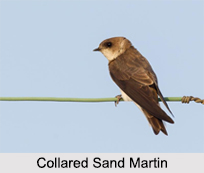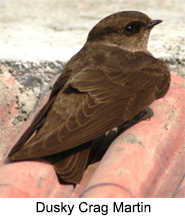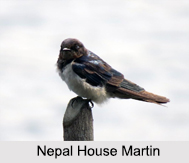 The Indian Subcontinent provides shelter to various species of birds for residing and nesting. Martins are no exception in this regard. Various Martins have been recorded in India. Some of these martins are described below.
The Indian Subcontinent provides shelter to various species of birds for residing and nesting. Martins are no exception in this regard. Various Martins have been recorded in India. Some of these martins are described below.
Collared Sand Martin
Collared Sand Martin winters in the Indian Subcontinent. This long bird has brown upper body and white lower body. There is a narrow brown band on the breast of the bird. The bill of the bird is black in color. The bird has brown colored legs. If the bird has rufous tips to the coverts and margins to the secondaries, it can then be identified as a young bird. Sand Martin can be distinguished from similar swallows in terms of brown back, white throat, small size and quick jerky flight.
Dusky Crag Martin
Dusky Crag Martin is a broad bodied bird with sooty-brown upperparts and slightly paler underparts. The eyes are brown in color. The bill of the bird is small and mainly black. The bird has a streaked pale dull rufous chin, throat and foreneck. The bird has dark brown underwing coverts. The legs are brownish-pink in appearance. The tail of the bird is short and square. Male and female Dusky Crag Martins are known to be similar. If the bird has rufous grey tips to the plumage of the upperparts and wings, it can then be identified as a juvenile. Two subspecies of Dusky Crag Martin are resident breeding birds of the Indian Subcontinent.
Nepal House Martin
The adult Nepal House Martin has blue-black upperparts and white lower body. This long bird has brown eyes and black colored bill. It has pure white rump. The bird has brownish-black upperwings and grey-brown underwings. The legs and feet are brownish-pink and covered with white feathers. Two subspecies of Nepal House Martin have been recorded in northwestern India.
Grey-Throated Martin
Grey-Throated Martin has been traced in the northern Indian Subcontinent. This martin has dark grey-brown upper body. Its throat and breast are uniformly pale grey-brown in appearance. The belly of the bird is whitish and its rump is pale. The wings and tail are blackish in appearance. The tail of the bird appears square or slightly forked. Male and female Grey-Throated Martins are known to be similar.



















